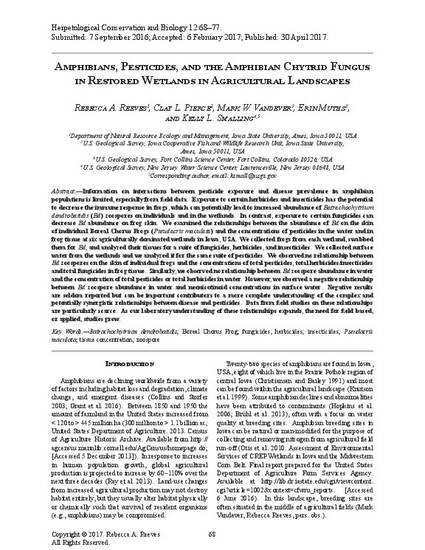
Information on interactions between pesticide exposure and disease prevalence in amphibian populations is limited, especially from field data. Exposure to certain herbicides and insecticides has the potential to decrease the immune response in frogs, which can potentially lead to increased abundance of Batrachochytrium dendrobatidis (Bd) zoospores on individuals and in the wetlands. In contrast, exposure to certain fungicides can decrease Bd abundance on frog skin. We examined the relationships between the abundance of Bd on the skin of individual Boreal Chorus Frogs (Pseudacris maculata) and the concentrations of pesticides in the water and in frog tissue at six agriculturally dominated wetlands in Iowa, USA. We collected frogs from each wetland, swabbed them for Bd, and analyzed their tissues for a suite of fungicides, herbicides, and insecticides. We collected surface water from the wetlands and we analyzed it for the same suite of pesticides. We observed no relationship between Bd zoospores on the skin of individual frogs and the concentrations of total pesticides, total herbicides/insecticides and total fungicides in frog tissue. Similarly, we observed no relationship between Bd zoospore abundance in water and the concentration of total pesticides or total herbicides in water. However, we observed a negative relationship between Bd zoospore abundance in water and neonicotinoid concentrations in surface water. Negative results are seldom reported but can be important contributors to a more complete understanding of the complex and potentially synergistic relationships between disease and pesticides. Data from field studies on these relationships are particularly scarce. As our laboratory understanding of these relationships expands, the need for field based, or applied, studies grow.
Available at: http://works.bepress.com/clay_pierce/57/

This article is published as Reeves, Rebecca A., Clay L. Pierce, Mark W. Vandever, Erin Muths, and Kelly L. Smalling. "Amphibians, Pesticides, and the Amphibian Chytrid Fungus in Restored Wetlands in Agricultural Landscapes." Herpetological Conservation and Biology 12 (2017): 68-77.